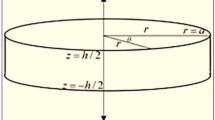Abstract
Theoretical fundamentals of the method to determine thermal diffusivity from auto-oscillation parameters in a control system, CS, with thermal feedback through the test specimen, are developed. The equation of a CS with a flat specimen and proportional controller (nonlinear boundary value problem of nonstationary heat conduction) is considered. Periodic solutions of the boundary value problem, which is linearized in the vicinity of the stationary solution, are analyzed. It is proved that, with a certain value of CS gain factor, excitation of auto-oscillations occurs. Their frequency ωc is related to the thermal diffusivity α as α = Cωc, where C is constant. By nonlinear analysis, it is revealed that the auto-oscillation excitation mode is soft and the frequency depends on the gain factor to a very weak degree. Formulas for calculation of the thermal diffusivity and the specimen temperature field are obtained.
Similar content being viewed by others
Abbreviations
- A :
-
Generalized gain factor
- A c :
-
Critical value of A
- a :
-
Thermal diffusivity
- b 2, c2 :
-
Lyapunov coefficients
- K :
-
Controller gain
- k :
-
Wavenumber
- q :
-
Heat flux
- R :
-
Heater resistance
- S :
-
Heater surface area
- T(x, t) :
-
Difference between specimen and thermostat temperatures
- t :
-
Real time
- u 0 :
-
Reference voltage
- u 1,u2 :
-
Voltage
- x :
-
Coordinate
- x 0 :
-
Thermocouple coordinate
- β :
-
Thermo emf factor
- δ :
-
Specimen thickness
- ɛ:
-
Relative deflection of A from A c
- η :
-
Thermocouple normalized coordinate
- λ :
-
Thermal conductivity
- v :
-
Temperature wave phase delay through the whole specimen
- ξ:
-
Auto-oscillation amplitude
- σ:
-
Heaviside step function
- τ :
-
Normalized time
- ¢:
-
Spatial part of phase
- ω:
-
Frequency
References
R. E. Taylor and K. D. Maglic, in Compendium of Thermophysical Property Measurement Methods, Vol. 1, K. D. Maglić, A. Cezairliyan, and V. E. Peletsky, eds. (Plenum, New York, 1984), pp. 305–336.
L. P. Phyllipov, in Compendium of Thermophysical Property Measurement Methods, Vol. 1, K. D. Maglić, A. Cezairliyan, and V. E. Peletsky, eds. (Plenum, New York, 1984), pp. 337–365.
M. Savvides and W. Murray, J. Phys. E 11:941 (1978).
B. D. Hassard, N. D. Kasarinov, and Y.-H. Wan, Theory and Application of Hopf Bifurcation (Cambridge University Press, Cambridge, 1981), pp. 10–17.
V. P. Alekseev, S. E. Birkgan, U. N. Burtsev, A. S. Rudyi, and S. N. Shehtman, J. Eng. Phys. (Russian) 52:255 (1987).
Author information
Authors and Affiliations
Rights and permissions
About this article
Cite this article
Rudyi, A.S. Theoretical fundamentals of the method for thermal diffusivity measurements from auto-oscillation parameters in a system with a thermal feedback. Int J Thermophys 14, 159–172 (1993). https://doi.org/10.1007/BF00522669
Received:
Issue Date:
DOI: https://doi.org/10.1007/BF00522669




